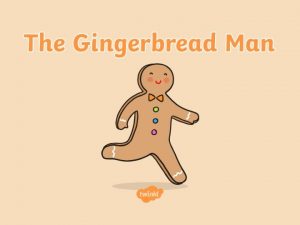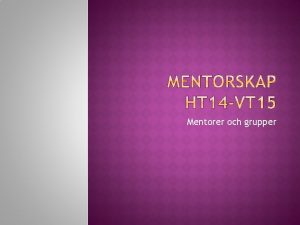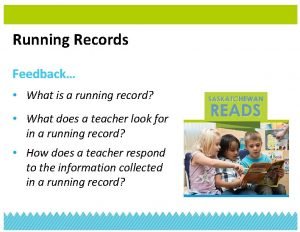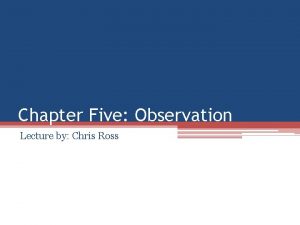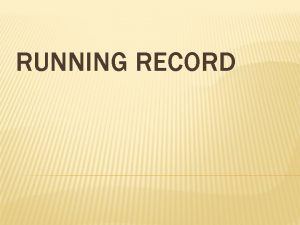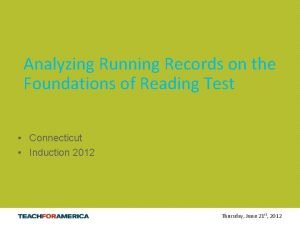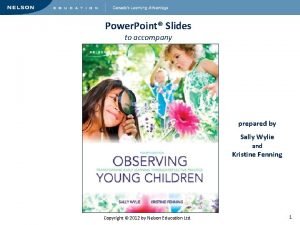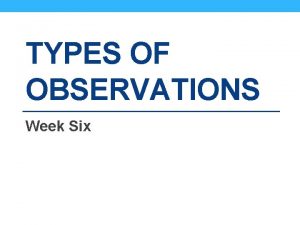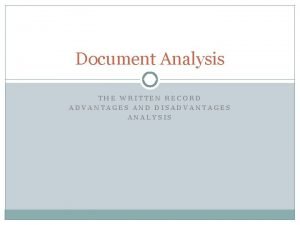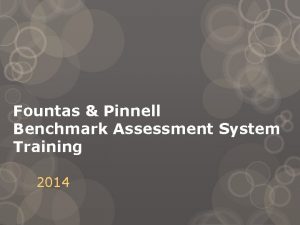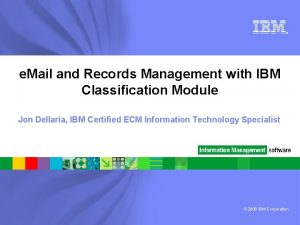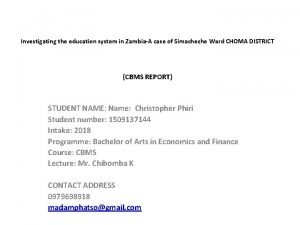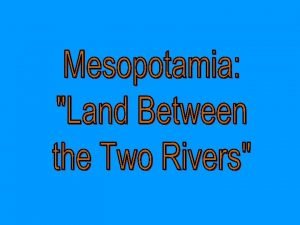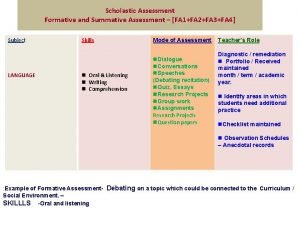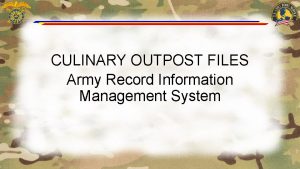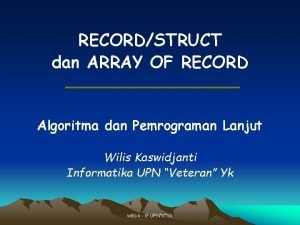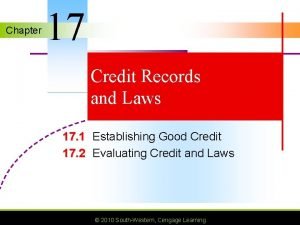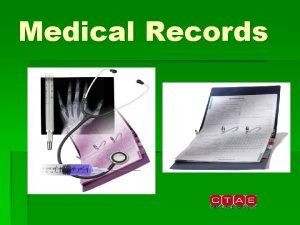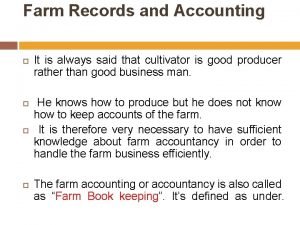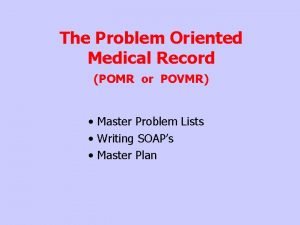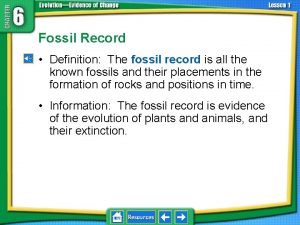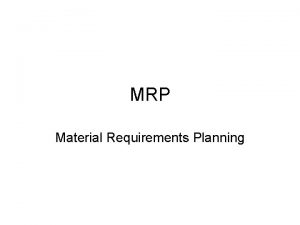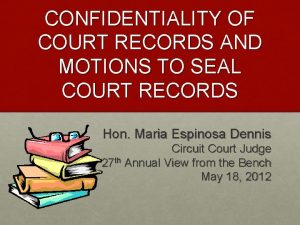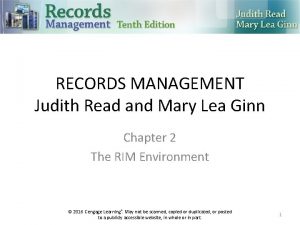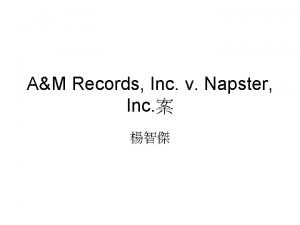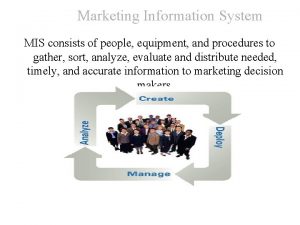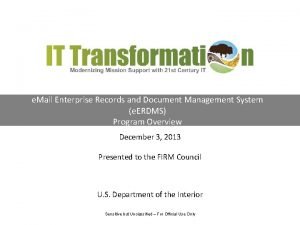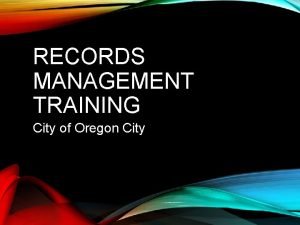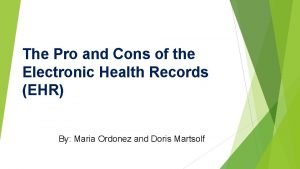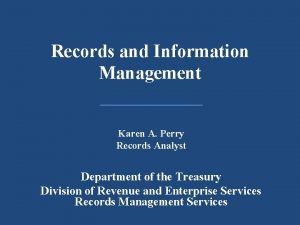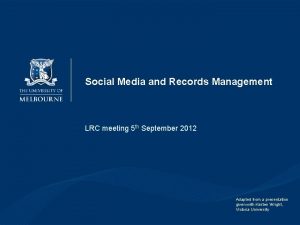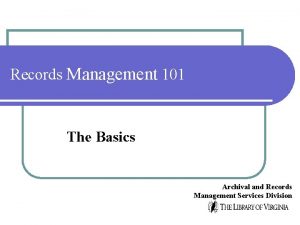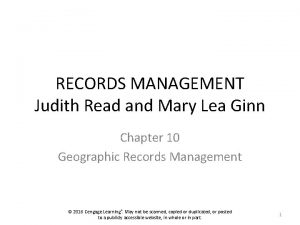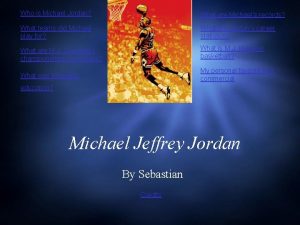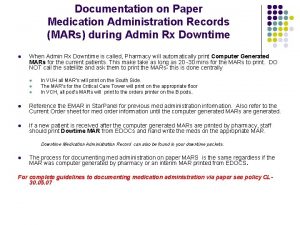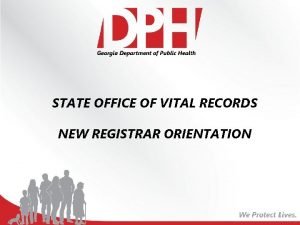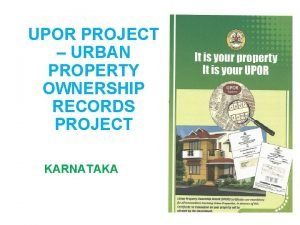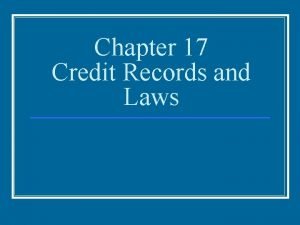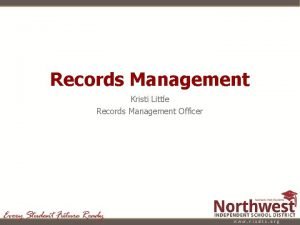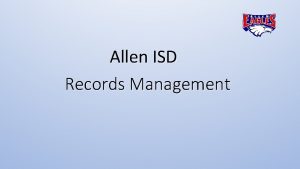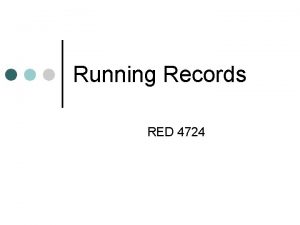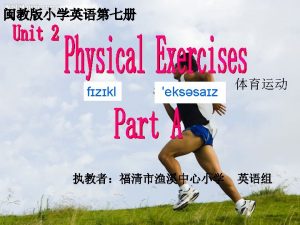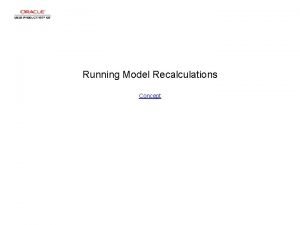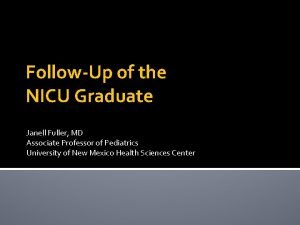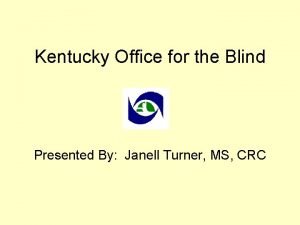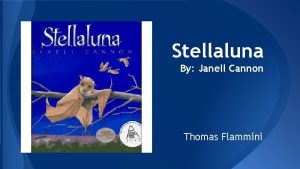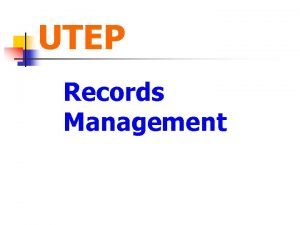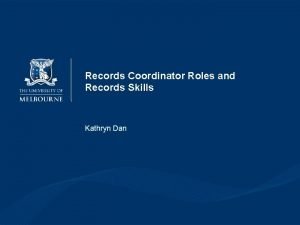Running Records Janell Koesel What is a Running




















































- Slides: 52

Running Records Janell Koesel

What is a Running Record? A running record is a means of documenting a student’s individual reading behaviors. A running record captures the student’s oral reading process and provides the teacher with the appropriate level of text for reading. The running record offers the teacher evidence of what the student is able to do, what the student is ready to learn, and what the student has learned over time. Teachers who master the taking of running records will be able to make powerful observations that can serve as immediate or long-term teaching tools. 2 p. 37

How Often do I Take a Running Record? Following is a suggested schedule: • Below grade level: once every 2 weeks • On grade level: once a month or if student is ready to be benchmarked • Above grade level: when student is ready to be benchmarked Running records should be collected in a data binder for documentation and justification of an action. 3

Materials ◍ ◍ ◍ Student’s text Running Record form or paper Pencil 4

Running“ Record Symbols and Marking Conventions 5

Accurate Reading I am packing my toothbrush. 6

Substitutions wrong correct I am packing my toothpaste. 7

Omission or - I am packing my hairbrush. 8

Insertion ˄ I am packing my book. 9

Repetition I am packing my pillow. 10 R

Self-correction sc I am packing my blanket. 11

Word told by Teacher T I am packing my teddy bear. 12

Sounding Out I am packing my pajamas. 13

Appeal to Teacher for Help A I am packing my vitamins. 14

Reversal of Words I am spending the night at Grandma and Grandpa’s. 15

https: //www. youtube. com/watch? v=ZO-4 OYi. Ji. UA 16

Try one! 17

Silver hopped S I hoped I was running toward˄our house. The sun had begun to set and the darkness seemed to be coming to meet me. Mom and Dad and I had often walked here in summer, un sc but now everything that was familiar was covered with snow. ˄ 18

R I wasn’t sure where I was. Silver was growing heavy, but I held on to him and tried not to think what would happen to us if I got lost. A The wind started up, covering my tracks as soon as I made them, so there was no way I could tell if I was going in a circle. 19

Now What? 20

Meaning Structure Visual 21

22




Let’s try some together… M S 26 V

What if the reader said, “It was a hit day. ” Instead of “It was a hot day. ” Does it make sense? Sound right? Look right? M S 27 V

Grandpa knits hats… Student 1&2

Level One Analysis Mathematical calculation: 29

Level Two Analysis Beyond mathematical calculation (MSV): 30

Level Three Analysis: Look at the cues being used and that are neglected. How is the student using the cues? Is the student actively checking on predictions? Did the student re-read to confirm or to pick up more information? 31

Student 1 Student 2 Re-reads when a mismatch appears Doesn’t re-read Re-reads after being told a word Doesn’t re-read Usually predicts when unsure Doesn’t often predict when unsure Seeks help when necessary Doesn’t seek help when necessary 32

YOUR TURN! Old Teeth, New Teeth 33

As a table group, use the completed running records to: 1. Mark the cuing systems being used and neglected • MSV 2. Analyze the processing • What is being done well? • What is the student struggling with or ignoring? 3. Select teaching points • Select a teaching point for each student 34

What were your results? Student 1: Student 2: Dave A/T M S V our M S V give M S V judge M S V all R SC M S V need R SC M S V her R SC M S V jar A/T R M S V 35

Student 1: Lack of self-correction Makes no attempt to search further when meaning breaks down after a substitution Checking strategies are with the teacher and not the text After checking with the teacher, the student does not re-read to confirm or maintain meaning Student is not actively monitoring meaning 36

Student 2: High level of self-correction When self-corrections are made, the student returns to the beginning of the line to maintain meaning When helped by the teacher, the student takes the initiative to return to the beginning of the line Only difficulty is not a text difficulty; it is possible that this student had no concept of “jug” and took the initiative to ask for help 37

Now what?

39

40

41

42

Lucy Calkins Lessons Accuracy I can read the words Kindergarten 1 st Grade 2 nd Grade 3 rd Grade Cross checking. . . Do the pictures and/or 1 words look right? Do they sound right? Do they make sense? 1. 1 M, 1. 8 M, 1. 11 M, 3. 12 1. 12, 1. 12 M, 1. 13, 2. 9, 3. 2, 3. 15 1. 7, 1. 7 M, 1. 8 M, 1. 11, 2. 6 M, 2. 9 M, 4. 8 1. 14, 2. 5, 2. 13 Use the pictures. . . Do the words and pictures match? 2. 6 M, 3. 13 M 1. 8 3 Use beginning and ending sounds 2. 8, 2. 8 M, 3. 7, 3. 8, 3. 10 M, 3. 15 M 1. 10, 1. 10 M 4 Blend sounds; stretch and reread 3. 9 M, 3. 12 M 2. 8 2 5 Flip the sound 6 Chunk letters and sounds together 3. 9 7 Skip the word, then come back 8 Trade a word/guess a word that makes sense 1. 8, 1. 9 1. 14, 2. 8 M, 3. 10 1. 10 3. 8, 3. 8 M 1. 11, 2. 7 M 43 3. 7, 3. 9, 3. 15 M 2. 8 M

The Reading Strategies Book Accuracy I can read the words Cross checking. . . Do the pictures and/or words look 1 right? Do they sound right? Do they make sense? Lesson Number 3. 4, 3. 10, 3. 22 2 Use the pictures. . . Do the words and pictures match? 1. 12, 3. 1 3 Use beginning and ending sounds 3. 3, 3. 15 4 Blend sounds; stretch and reread 3. 12, 3. 16 5 Flip the sound 3. 17 6 Chunk letters and sounds together 3. 12, 3. 19, 3. 21 7 Skip the word, then come back 3. 20 8 Trade a word/guess a word that makes sense 3. 9 44

You have lessons in your folder! They are in English and Spanish! https: //www. thedailycafe. com/articles/literacy-cafe-menu 45 Strategy: Cross Checking… Do the pictures and/or words look right: Does it sound right? Does it make sense? Cross Checking is a strategy for ensuring the words (and sometimes pictures) Definition make sense and match the letters on the page. Why Students When what is read doesn’t sound right or make sense. Need This When students come to a word they don’t know. Strategy Must be able to monitor for meaning and know when it is necessary to pause and Secret to fix up the meaning instead of just continuing to read. Success Constantly grounding reading in meaning is vital to the success of this strategy. How We Teach It We have found that the best way to teach this strategy is by guiding children to stop at the end of a sentence when what they read didn’t make sense. We ask them to go back and find the word that was confusing. We give them highlighter tape or a special pointer to mark the word. We may also supply a sticky or even a clear acetate sheet and marking pen to lay over the text and circle the word. Once the word has been identified, we spend time teaching children the movements to go with Cross Checking: “Does the word I am reading match the letters written or the picture? ” (Here they cross their right arm over their body so the right hand touches the left shoulder. ) “Does it sound right? ” (Left arm crosses over the body so the left hand touches their right shoulder. ) Finally, “Does it make sense? ” (Both arms come down with hands pointing to the ground. ) By giving a kinesthetic motion to the strategy, children are more apt to remember the questions that go with it. Teaching and modeling this strategy over and over all year long so children get into the habit of using it will help them learn to become readers who self-monitor their reading by stopping when it doesn’t make sense and cross checking. Language we use: “While reading, ask yourself, ‘Do the picture and/or letters in the word match what I am saying? Does it sound right and does it make sense? ’” For this strategy to be viable for beginning readers, they must read pictures know some letters and some sounds know the location of the beginning of a word. For advanced readers to be successful with Cross Checking, they must understand decoding of word parts. Troubleshooting If a child has difficulty with this strategy, break down the process: Stop when meaning breaks down Look and say the letters, and the word chunks in words Use picture support Cross Check by asking if it looks right? Sounds right? And makes sense?

Every strategy has a parent letter explaining how to help at home! They are in English and Spanish! 46

http: //wiseowlcathy. blogspot. com/2015/05/be-reading-detectiveinvestigate-their. html 47

DRA 2: 4. Teacher Analysis 48

All 3 Cueing Systems Work Together Meaning Visual (semantic) (graphophonic) Comprehension Structure (syntactic) 49

“ How often should you give a running record to a student reading on grade level? 50

“ What is the symbol when a student looks to the teacher for help with a word? 51

“ If a student says “little” instead of “small” what cueing system is he NOT using? 52
 Running running running
Running running running Once upon a time a little man
Once upon a time a little man Sofie bennetoft
Sofie bennetoft What does msv mean in running records
What does msv mean in running records Disadvantages of running records
Disadvantages of running records Purpose of running records
Purpose of running records Mountain bike mania student copy
Mountain bike mania student copy Anecdotal example
Anecdotal example Running record notations
Running record notations Anecdotal observation example
Anecdotal observation example What are the disadvantages of written records
What are the disadvantages of written records Benchmark assessment system scoring
Benchmark assessment system scoring Tribal health ehr
Tribal health ehr Ibm enterprise records knowledge center
Ibm enterprise records knowledge center Dmrs medical records
Dmrs medical records Sra training record
Sra training record Safety performance history records request
Safety performance history records request Conclusion for school records
Conclusion for school records Cartersville medical center medical records
Cartersville medical center medical records Debbie gearhart
Debbie gearhart Principles of medical records
Principles of medical records Kaiser santa rosa er
Kaiser santa rosa er Kabihasnang sumer map
Kabihasnang sumer map Scholastic records example
Scholastic records example Arims labels
Arims labels Algoritma records
Algoritma records Chapter 17 records
Chapter 17 records Are medical records legal documents
Are medical records legal documents Farm records and accounts
Farm records and accounts Pomr record system
Pomr record system Analogous defintion
Analogous defintion Material
Material Motion to determine confidentiality of court records
Motion to determine confidentiality of court records Records management disaster recovery plan
Records management disaster recovery plan Records management mary l. ginn
Records management mary l. ginn Marilyn hall patel
Marilyn hall patel Types of medical documentation
Types of medical documentation Mis consists of
Mis consists of Kentucky vaccine registry
Kentucky vaccine registry Auto classification records management
Auto classification records management Oregon public records retention schedule
Oregon public records retention schedule Pros and cons of electronic health records
Pros and cons of electronic health records Artemis records retention
Artemis records retention Social media records management
Social media records management Records management 101
Records management 101 Geographic records management
Geographic records management Records michael jordan holds
Records michael jordan holds Certified records manager certification
Certified records manager certification Paper medication administration record
Paper medication administration record Birth certificate georgia
Birth certificate georgia Upor karnataka
Upor karnataka Feeone
Feeone Chapter 17 records
Chapter 17 records
